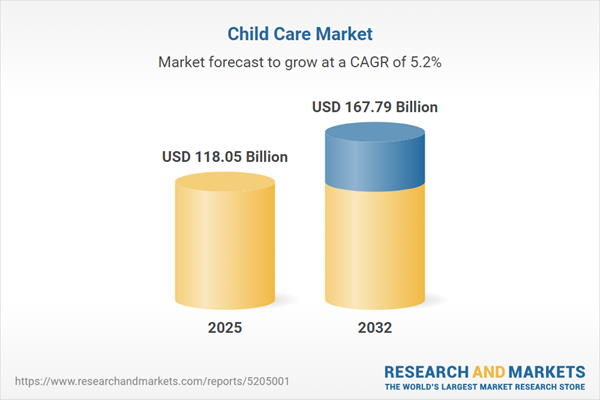Speak directly to the analyst to clarify any post sales queries you may have.
Senior decision-makers need actionable insights to navigate the United States child care market’s ongoing shifts in regulation, consumer expectations, and competitive pressures. As providers adapt, effective strategies and informed decisions are critical for operational excellence and sustained market presence.
Market Snapshot: United States Child Care Market
The United States child care market is projected to reach USD 118.05 billion in 2025, rising from USD 112.19 billion in 2024. This growth, reflecting a compound annual growth rate (CAGR) of 5.16%, is underpinned by increased workforce participation and enhanced focus on early childhood learning. Providers are advancing digital capabilities and reinforcing compliance to align with evolving expectations. A dynamic competitive environment is prompting organizations to prioritize adaptability, bringing forward resilient service models and expanded technology use to secure operational stability.
Scope & Segmentation
- Service Types: National centre-based programs deliver standardized early education, while home-based and personalized care models meet varied family requirements for flexible solutions.
- Age Groups Served: Providers serve infants, toddlers, preschoolers, and school-age children, ensuring support across each developmental stage and fulfilling after-school needs.
- Ownership Models: For-profit enterprises, public non-profit bodies, and independent providers each contribute distinct quality assurance and governance mechanisms within the market.
- Payment Modes: Services are accessed through employer-sponsored subsidies, government initiatives, and direct family payments, broadening affordability and increasing the addressable customer base.
- Price Tiers: Packages range from entry-level and mid-range to premium, reflecting a commitment to serve various budget points and maintaining quality standards across the spectrum.
- Regional Coverage: North America, Europe, the Middle East & Africa, and Asia-Pacific each feature unique regulatory contexts and technology adoption rates, requiring localized strategies and technology integration for effective service delivery.
- Leading Companies: Brands such as Bright Horizons Family Solutions Inc., KinderCare Education LLC, Learning Care Group LLC, and G8 Education Limited influence industry trends and set benchmarks in quality and operational processes.
- Core Technologies: Management software, mobile enrollment tools, and compliance automation platforms streamline administration and facilitate transparent communication with parents and stakeholders.
Key Takeaways for Senior Decision-Makers
- Flexibility in service design enables organizations to accommodate rapidly changing family needs and remain aligned with shifting consumer expectations.
- Adopting digital transformation strategies enhances transparency, parent engagement, and process efficiency, supporting stronger connections between providers and families.
- Continued compliance focus allows organizations to adapt smoothly to new policies, safeguarding reputation and maintaining uniform service quality.
- Cultivating and retaining skilled personnel increases care quality, reduces operational risks, and strengthens organizational resilience.
- Diversifying offerings supports access to broader demographics and promotes agility in response to evolving market conditions.
- Employing localized approaches—such as workplace integration or region-specific digital outreach—creates a competitive advantage and strengthens regional market positioning.
Tariff Impact on Providers and Supply Chains
Recent changes in tariffs are increasing supply costs and affecting availability, compelling providers to pursue domestic sourcing and collective purchasing models. These responses help mitigate financial risk, control costs, and underpin reliable service delivery as the market environment evolves.
Methodology & Data Sources
This report integrates direct interviews with licensed child care operators, expert analysis, and structured assessments of regulatory frameworks. Data is validated against industry benchmarks and third-party information to ensure outcomes are credible and directly relevant for executive planning.
Why This United States Child Care Market Report Matters
- Enables leadership teams to anticipate sector developments and proactively refine strategy amid evolving child care regulations and expectations.
- Provides targeted intelligence on advancing workforce models and digital management tools, supporting informed resource allocation and operational investment.
- Supports comprehensive risk identification and adaptive positioning for organizations seeking sustainable progress in a rapidly changing environment.
Conclusion
This report supplies senior executives with the intelligence needed to align child care services with innovative practices and regulatory trends, supporting organizational stability in an increasingly sophisticated market.
Additional Product Information:
- Purchase of this report includes 1 year online access with quarterly updates.
- This report can be updated on request. Please contact our Customer Experience team using the Ask a Question widget on our website.
Table of Contents
3. Executive Summary
4. Market Overview
7. Cumulative Impact of Artificial Intelligence 2025
List of Figures
Companies Mentioned
The companies profiled in this Child Care market report include:- Bright Horizons Family Solutions Inc.
- KinderCare Education LLC
- Learning Care Group LLC
- G8 Education Limited
- Busy Bees Group Limited
- The Goddard Systems, Inc.
- Primrose Schools LLC
- The Learning Experience LLC
- Kids 'R' Kids International, Inc.
- Kiddie Academy International, LLC
Table Information
| Report Attribute | Details |
|---|---|
| No. of Pages | 187 |
| Published | November 2025 |
| Forecast Period | 2025 - 2032 |
| Estimated Market Value ( USD | $ 118.05 Billion |
| Forecasted Market Value ( USD | $ 167.79 Billion |
| Compound Annual Growth Rate | 5.1% |
| Regions Covered | Global |
| No. of Companies Mentioned | 11 |









